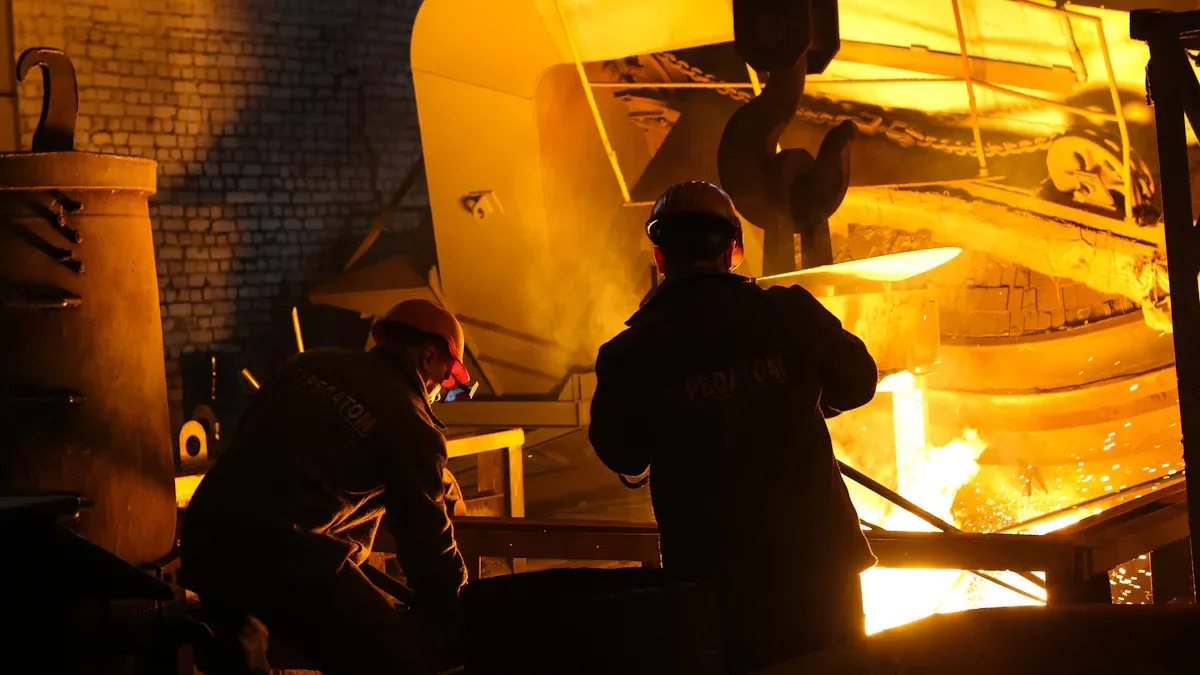Understanding Casting Shrinkage Allowance and Machining Allowance

Casting methods need to be precise for correct final sizes. Metals shrink when they cool and harden, which is why Casting Shrinkage Allowance and Machining Allowance are crucial. Shrinkage allowance adds extra material in the mold to compensate for this shrinkage. Machining allowance ensures there is enough material left for cutting and finishing to achieve exact sizes.
Type of metal
Grey cast iron
0.55% – 1.00%
White cast iron
2.10%
Aluminum
1.65%
Brass
1.30% – 1.55%
Bronze
1.05% – 2.10%
These allowances help maintain the correct size and quality. For example, steel might require up to 20.8 mm/m of Casting Shrinkage Allowance to align with the design specifications.
Casting Shrinkage Allowance
Definition and Purpose
Casting shrinkage allowance means adding extra material to molds. This helps when molten metal cools and shrinks. Metals get smaller as they harden because their atoms pack closer together. This allowance ensures the final product matches the planned size. Without it, the casting might be too small and need fixing or get rejected.
Different metals shrink differently, so allowances vary. Aluminum alloys in sand casting need 1.0–1.5% extra material. Steel needs 1.5–2.0%. These numbers help make up for the shrinking during cooling.
Causes of Shrinkage in Metals
Metals shrink because their density changes as they cool. When liquid metal turns solid, its atoms move closer, making it smaller. Metals like aluminum and copper shrink more because they conduct heat well.
The casting method also affects shrinkage. Sand casting lets metals shrink freely. Die casting molds hold the metal tighter, limiting shrinkage. Below is a table showing shrinkage percentages for different methods:
Metal | Sand Casting (%) | Die Casting (%) | Investment Casting (%) | Lost Foam Casting (%) |
|---|---|---|---|---|
Aluminum Alloys | 1.0 – 1.5 | 0.5 – 1.0 | 1.2 – 1.8 | 1.0 – 1.5 |
Magnesium Alloys | 1.3 – 1.8 | 0.8 – 1.2 | 1.5 – 2.0 | 1.3 – 1.8 |
Zinc Alloys | 0.8 – 1.2 | 0.3 – 0.7 | 1.0 – 1.5 | 0.8 – 1.2 |
Copper Alloys | 1.0 – 1.5 | 0.8 – 1.2 | 1.2 – 1.8 | 1.0 – 1.5 |
Cast Iron | 0.8 – 1.2 | 0.5 – 0.8 | 1.0 – 1.5 | 0.8 – 1.2 |
Steel | 1.5 – 2.0 | 1.0 – 1.5 | 1.8 – 2.3 | 1.5 – 2.0 |
Factors Influencing Shrinkage Allowance
Many things affect how much shrinkage allowance is needed. The type of metal matters because each shrinks differently. For example, gray cast iron needs 1.0%, but austenitic steel may need up to 2.3%.
The casting method also changes shrinkage. Free shrinkage happens when molds let metals shrink easily. Hindered contraction occurs when molds stop the metal from moving much. The table below shows shrinkage values for free and hindered contraction:
Types of Alloy | Free Shrinkage | Hindered Contraction |
|---|---|---|
Carbon steel & low alloy steel | 1.6 ~ 2.0 | 1.3 ~ 1.7 |
High Cr alloy steel | 1.3 ~ 1.7 | 1.0 ~ 1.4 |
Ferritic austenitic steel | 1.8 ~ 2.2 | 1.5 ~ 1.9 |
Austenitic steel | 2.0 ~ 2.3 | 1.7 ~ 2.0 |
Gray cast iron | 1.0 | 0.9 |
Nodular cast iron | 1.0 | 0.8 |
Studies show better shrinkage formulas improve casting accuracy. Car makers cut engine block errors by 70% using new aluminum-silicon formulas. Aerospace companies reduced machining by 95% for titanium turbine blades with advanced shrinkage calculations. These examples show why shrinkage allowances must fit specific needs.
Methods for Calculating Shrinkage Allowance
Knowing how to calculate shrinkage allowance is very important. It helps make sure castings have the right size. There are different ways to figure out the allowance. These include simple formulas and advanced computer simulations. Each method is chosen based on the metal type and casting process.
1. Empirical Formulas
Empirical formulas are easy to use for shrinkage allowance. They are based on past data and observations. For example, you can multiply the mold's size by a shrinkage percentage. This percentage depends on the metal, like aluminum or cast iron. These metals have well-known shrinkage rates, so this method works well for them.
2. Numerical Methods
Numerical methods are more accurate for calculating shrinkage allowance. They use math models to predict how metal shrinks as it cools. Techniques like finite element analysis (FEA) solve equations to show shrinkage behavior. These methods are great for complex casting processes.
The table below shows some numerical methods and how they are tested:
Source | Type of Evidence | Description |
|---|---|---|
Modelling feeding flow related shrinkage defects in aluminum castings | Numerical Method | Uses a 3-D finite difference method for casting systems. |
Shrinkage Estimation of Cast Al–Si Alloys through Process Simulation | Validation Technique | Combines simulations with real-world experimental data. |
Numerical Method | Uses finite element methods and tests with experiments. | |
Experimental Validation | Measures shrinkage and compares it with predictions. | |
Solidification Simulation of Aluminum Alloy Casting – A Theoretical and Experimental Approach | Numerical Method | Simulates solidification using finite element methods. |
3. Experimental Validation
Experimental validation checks if shrinkage allowance calculations are correct. It compares simulation results with real casting experiments. For example, manufacturers measure cast parts and compare them to predictions. This helps improve the accuracy of the models.
4. Process Simulation Software
Special software is often used to predict shrinkage allowance. These tools combine math models and experimental data. By entering details like metal type and cooling speed, the software creates accurate simulations. These simulations help design better molds.
Tip: Using both numerical methods and experiments gives the best results. This reduces mistakes and ensures the casting matches the design.
By using these methods, you can improve casting accuracy. Whether you use simple formulas or advanced tools, pick the method that suits your needs.
Machining Allowance
Definition and Purpose
Machining allowance means adding extra material to a part. This ensures the final size is correct after machining. During machining, tools cut away material to shape the part. This process can cause small errors like tool wear or vibrations. The extra material helps fix these errors and meet the required size.
For example, in CNC machining, cutting forces can cause mistakes. Machining allowance fixes these issues and prevents the part from shrinking or bending. It also helps tools last longer by allowing for wear during use.
Importance in Precision Machining
Machining allowance is very important for precise machining. It ensures the part fits perfectly, especially for tight spaces. Sometimes, uneven cutting or bending happens during machining. The allowance gives extra material to fix these problems without ruining the part.
In factories, machining allowance avoids costly mistakes. If a part doesn’t have enough allowance, it might need extra work, wasting time and money. It also ensures all parts are the same size and quality.
Tip: Always calculate machining allowance carefully to save material and time.
Factors Determining Machining Allowance
Several things decide how much machining allowance is needed:
Material Type: Softer metals like aluminum need less allowance than harder ones like steel.
Machining Process: Processes like grinding need smaller allowances than rough cutting.
Tool Wear: Tools wear out over time, so allowance helps keep results accurate.
Workpiece Size and Complexity: Bigger or more detailed parts may need more allowance for errors.
Production Volume: Making many parts often needs smaller allowances to save material and time.
When calculating machining allowance, think about these factors. For example, in CNC machining, it helps fix cutting mistakes and tool wear. This ensures the part is the right size and tools last longer.
Typical Machining Allowance Values Across Industries
Machining allowance changes depending on the industry. Different materials and processes need specific adjustments. Industries like automotive, aerospace, and heavy machinery follow strict standards. These standards help parts meet exact sizes after machining.
1. Automotive Industry
The automotive industry needs machining allowance for engine parts and gears. Smaller allowances save material and lower costs. Common values are 0.5 mm to 3 mm, based on material and process. Examples include:
Engine blocks (cast iron): 1.5 mm – 2.5 mm
Transmission gears (steel): 0.8 mm – 1.2 mm
2. Aerospace Industry
Aerospace parts need very tight tolerances. Safety and performance are top priorities. Smaller allowances reduce waste and ensure precision. Typical values are:
Aluminum alloys for fuselage parts: 0.5 mm – 1.0 mm
Titanium alloys for turbine blades: 0.8 mm – 1.5 mm
Note: Advanced CNC machines are often used in aerospace for precise machining.
3. Heavy Machinery Industry
Heavy machinery parts, like those in construction, need larger allowances. These parts use strong materials like steel or cast iron. Usual allowances range from 2 mm to 6 mm. Examples include:
Hydraulic cylinders (steel): 3 mm – 5 mm
Gear housings (cast iron): 2 mm – 4 mm
4. Medical Device Industry
Medical devices, such as implants, need high accuracy. Small machining allowances ensure safety and precision. Common values are:
Stainless steel implants: 0.2 mm – 0.5 mm
Titanium surgical tools: 0.3 mm – 0.8 mm
5. General Manufacturing
In general manufacturing, allowances depend on material and part complexity. Examples include:
Plastic components: 0.1 mm – 0.3 mm
Steel brackets: 1 mm – 2 mm
Industry | Material | Typical Machining Allowance |
|---|---|---|
Automotive | Cast Iron, Steel | 0.5 mm – 3 mm |
Aerospace | Aluminum, Titanium | 0.5 mm – 1.5 mm |
Heavy Machinery | Steel, Cast Iron | 2 mm – 6 mm |
Medical Devices | Stainless Steel, Titanium | 0.2 mm – 0.8 mm |
General Manufacturing | Plastic, Steel | 0.1 mm – 2 mm |
Tip: Check industry standards and material details before deciding machining allowance. This avoids waste and ensures precision.
Knowing these values helps you plan machining better. Whether using steel, aluminum, or plastic, the right allowance improves accuracy and saves time.
Comparing Casting Shrinkage Allowance and Machining Allowance
Differences in Purpose and Application
Casting shrinkage allowance and machining allowance have different jobs in manufacturing. Shrinkage allowance adds extra material to make up for metal shrinking as it cools. This helps the casting match the planned size. Machining allowance, however, leaves extra material for cutting and shaping during machining. This ensures the final part is the right size and shape.
These allowances are used at different times. Shrinkage allowance is added when designing the mold. It ensures the casting stays accurate after cooling. Machining allowance is used later, during finishing, to remove extra material and meet exact measurements.
Type of Metal | Shrinkage Allowance (%) | Machining Allowance (mm) |
|---|---|---|
Grey Cast Iron | 0.55 – 1.00 | 3.0 – 10.0 |
Aluminum | 1.65 | 1.5 – 5.0 |
Cast Steel | 2.00 | 4.3 – 12.0 |
Role in the Casting Process
Both allowances are important but at different steps. Shrinkage allowance handles three types of shrinkage: liquid, solidification, and solid shrinkage. For instance, liquid shrinkage reduces volume by 1% to 3%. Solidification shrinkage can cause a 3% to 7% size decrease. These allowances prevent cracks or size problems by adjusting the mold.
Machining allowance helps during the cutting process. It ensures the casting stays strong while being machined. It also accounts for tool wear, vibrations, and small mistakes. Without this allowance, getting the exact size would be hard.
Type of Shrinkage | Description | Typical Shrinkage Rate |
|---|---|---|
Liquid Shrinkage | Volume reduces as molten metal cools to solid. | 1% – 3% |
Solidification Shrinkage | Size decreases during liquid-to-solid change. | 3% – 7% |
Solid (Patternmaker’s) Shrinkage | Shrinks as casting cools to room temperature. | 1% – 2.5% |
Impact on Final Product Dimensions
Both allowances affect the final product's size. Shrinkage allowance ensures the casting is not too small after cooling. Machining allowance ensures the size is perfect after cutting away extra material.
For example, a steel casting with 2% shrinkage allowance and 4.3 mm machining allowance will meet exact size needs. Ignoring either allowance can cause size errors, higher costs, or rejected parts. By calculating both carefully, you can create high-quality castings that meet design goals.
Practical Applications of Casting Shrinkage Allowance and Machining Allowance
Example of Shrinkage Allowance in Mold Design
Shrinkage allowance is important when designing molds. It helps ensure the final casting matches the planned size. For example, ABS HG121 has a shrinkage rate of 0.005. This means the mold must be slightly bigger than the part's original size.
Here’s a table showing how shrinkage allowance changes mold dimensions:
Dimension ID | Original Size | Material | Shrinkage Rate | Mold Size |
|---|---|---|---|---|
DIM-001 | 200.00 mm | ABS HG121 | 0.005 | 201.005 mm |
DIM-002 | 100.00 mm | PA6-GF30 | 0.003 | 100.301 mm |
DIM-003 | 100.00 mm | PA6-GF30 | 0.009 | 100.908 mm |
DIM-004 | 10.00 mm | ABS HG121 | 0.005 | 10.050 mm |
DIM-005 | 5.00 mm | ABS HG121 | 0.005 | 5.025 mm |
This adjustment keeps the product size accurate after cooling. Below is a bar chart comparing original and mold sizes for better understanding:
Using shrinkage allowance correctly avoids mistakes and ensures accurate castings.
Example of Machining Allowance in Precision Engineering
Machining allowance adds extra material to fix errors during machining. It helps with tool wear, vibrations, and small deformations. For example, adding 2 mm on shaped parts and 6 mm on sides can prevent problems.
This ensures the final product meets exact measurements. In aerospace, machining allowances are very important for tight tolerances. Turbine blades made from titanium alloys often need allowances between 0.8 mm and 1.5 mm for precision.
Machining allowance also reduces waste. It prevents rework and saves material by fixing errors during machining. This saves time and ensures all parts are high quality.
Tip: Always calculate machining allowance based on the material and process for better results.
Challenges and Best Practices in Applying Allowances
Using casting and machining allowances can be tricky. Shrinkage rates differ by material, making it hard to predict sizes. For example, tool production may need 2% shrinkage compensation for 3D-printed sliders.
Machining allowances can also raise costs. Studies show hybrid designs reduce printed height by 10–20%. But too much allowance wastes material and increases expenses.
To solve these problems, follow these tips:
Know Material Properties: Learn the shrinkage rate and machining behavior of your material.
Use Simulation Tools: Predict shrinkage and machining results with software.
Test with Experiments: Check molds and machined parts to confirm allowances work.
Balance Allowance Values: Use just enough allowance to avoid waste and ensure accuracy.
By following these steps, you can make manufacturing more efficient and get better results.
FAQ
1. What is the difference between shrinkage allowance and machining allowance?
Shrinkage allowance adds extra material for cooling shrinkage. Machining allowance adds material for cutting and shaping. Shrinkage allowance is used in mold design, while machining allowance is used during finishing.
2. How do you calculate shrinkage allowance?
Multiply the mold size by the metal's shrinkage rate. For example, aluminum needs 1.0–1.5% extra material. Software tools can also predict shrinkage more accurately.
3. Why is machining allowance important?
Machining allowance ensures the part is the right size after cutting. It helps fix tool wear, vibrations, and small mistakes. Without it, getting exact dimensions would be hard.
4. Can shrinkage and machining allowances be used together?
Yes, both allowances are used together. Shrinkage allowance keeps the casting accurate after cooling. Machining allowance ensures the final size is correct after finishing.
5. What happens if allowances are miscalculated?
Wrong allowances cause size errors and waste material. This increases costs and may require fixing or rejecting parts. Accurate calculations save time and ensure quality.
See Also
Exploring CAE Analysis Advantages for Die Casting Design
A Supplier's Guide to CBAM and Sustainable Casting
Comprehensive Guide to CAD Design in Die Casting
An Overview of Jigs and Fixtures in Manufacturing
Understanding Functional Testing in CNC and Die Casting
About Hunan Puka
Established in 2016 and based in Hunan, China, with a liaison point in Berlin, we are a Tier 2 supplier for the automobile industry. We specialize in the production of customized aluminum die-casting parts designed for machines with a closing force ranging from 280 to 1250 tons, with subsequent manufacturing process CNC machining and surface treatment. Our commitment to quality is reflected in our accredited quality management system, certified by ISO9001:2015 and IATF16949:2016 standards.


